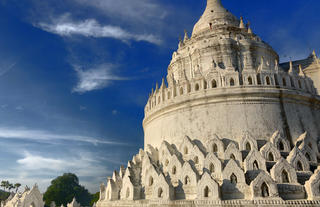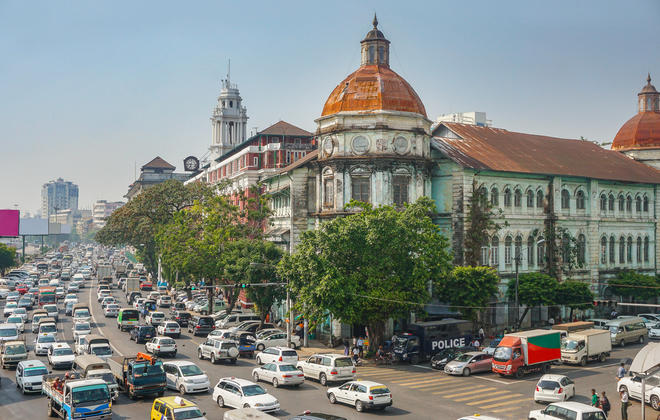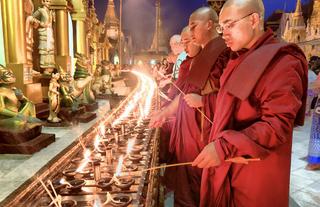Myanmar remains, as ever, a country shrouded in mystery. The hardest fought and least travelled paths in life, however, yield unforgettable memories. Stories that we pass onto generations. For the uninitiated, the sheer spread of ancient temples in Bagan, or the floating gardens and dancing fisherman of Inle Lake, or the stretches of powdery sand in Ngapali will not fail to astonish. Myanmar is a country that draws repeat visits, charming visitors to explore one more corner, understand one more facet. Today, Myanmar is open to the world after decades of isolation. As Southeast Asia’s second largest country and approximately the size of France and England combined, Myanmar is home a beautiful kaleidoscope of diversity of over 130 different ethnic groups.
Myanmar’s 2000 kilometers of coastline remain pristine and pure. Its terrain stretches from the snowcapped Himalayan peaks in the north, to the coral-fringed islands of the Andaman Sea in the south. It is a landscape of beauty and contrast, studded with pagodas and palaces, forested hills and fertile valleys. Myanmar fascinates with its mix of ancient cultures, ethnic minorities and diverse landscapes. Many tourist destinations offer sea and sun, relaxation and adventure, pleasure and discovery –Myanmar offers all this in an untouched, still-to-be discovered way.
The last royal capital of Myanmar. Mention of the word “Mandalay” conjures up sentiments of romance and tragedy, as immortalized in the literary gifts of George Orwell, Rudyard Kipling and Somerset Maugham. The true saga of the last reigning monarch King Thibaw, however, is imbued with romance and tragedy as much as any literary account. Through a combination of deceit, manipulation and false hopes stirred by court advisors and his wife, the fitful reign of King Thibaw ended when the British took Upper Burma in 1885. His family was exiled to India, where they lived in near poverty for the remainder of their lives. Before him, the struggles of the many ancient kings to gain control of the region were as complex and fantastical as a fairy tale.
With British rule, Mandalay’s streets were laid out on a grid system with the large, square palace compound of the former King Thibaw as its epicenter and surrounded by high, red walls and a moat. The effect is unlike any other city in Southeast Asia. With Myanmar’s highest concentration of monks, hundreds of monasteries, and legions of craftsmen, Mandalay is widely regarded as the religious and cultural heart of Myanmar. Among the most venerable pagodas are the Mahamuni Paya, now home to an ancient Buddha image from Rakhine State in western Myanmar, covered in gold leaf by devout Buddhists over many years; and Kuthodaw Paya, with 729 marble slabs bearing inscriptions of the entire Buddhist Tripitaka canon placed around the central stupa. According to legend, on a visit to Myanmar accompanied by his disciple Ananda, the Buddha climbed the 236 meter high Mandalay Hill overlooking the surrounding plains. Standing at the summit, he pointed with arm outstretched to where the Mandalay Palace stands today, and declared that a great city would be founded there after 2,400 years. That year corresponds to 1857 AD, when King Mindon ordered the move of the royal capital from Amarapura to a new city constructed at the foot of Mandalay Hill and bearing its name. Near the top of the hill, a standing Buddha image represents the prophecy.





Resting on the banks of the mighty Irrawaddy River, Old Bagan is both a wondrous UNESCO World Heritage Site and the core of the Bagan Archeological Zone. This charming destination is home to lovely museums, several magnificent temples, enticing shops, and mouth-watering cuisine. Must-see attractions include the famous Shwesandaw Pagoda; the exquisite red-brick facade of the Htilominlo Temple; the interesting exhibitions at the Bagan Archaeological Museum; and the panoramic views from the Atwin Zigon Pagoda. Enjoy a leisurely round of golf at the spectacular 18-hole Bagan Nyaung Oo Golf Club, or wander down to the waterfront and admire the spectacular views and bustling riverside trade.





The ancient capital of Myanmar’s south, Bago is now a bustling town located 80 kilometres from Yangon. The main attraction here lies just beyond the town centre: an impressive complex of ancient temples, reclining Buddha statues and pagodas dating back hundreds of years. Just a short trip from the current capital, Bago is well worth visiting to spend a few hours wandering or biking around the beautifully preserved ruins. When there, don’t miss Shwethar lyaung Pagoda, where you can see the second-largest reclining Buddha in the world or the 114-metre-high Shwe mawdaw Pagoda, otherwise known as the ‘Golden God Temple’.





With a population of over 5 million, Yangon, also known as Rangoon, was the capital of Myanmar up until the end of 2005. It remains the largest city, and is still the pivotal commercial hub of the country today. A visit to this magnificent city will allow you to take in the interesting mix of British, Burmese, Chinese and Indian cultures that mingle there. The skyline is an interesting contrast of decaying colonial architecture and modern high-rises, dominated by the golden glow of the Shwedagon Pagoda, an exquisite Buddhist temple that draws pilgrims from across the globe. Your time here would be well spent visiting the impressive array of temples, museums and markets that the city has to offer.
History Yangon in brief
European countries in a race to control trade routes had established trading posts in across South East Asia. East India Trading company controlled by the British had extended its operations to the Burmese coast and where trading with the Burmese kings. Three Anglo-Burmese wars flared up and in the second Anglo-Burmese war 1852 the British took over Southern Burma and made Rangoon its capital. The old name of Rangoon was Dagon. After third war in 1885 and ousting king Thibaw in Mandalay where the capital was located Rangoon became the capital for the whole country of Burma. Dr William Montgomerie sketched the new plan for the city and Lt Alexander Fraser from the Bengal Engineers implemented. Many architects were employed to fill in the city plan with schools, hospitals, parks, banks, shops and administrative buildings.
Fast forward… the colonial times are long gone, but in Yangon they have left behind a rich architectural heritage, of a type which many other capital cities of the region has been lost to “progress”. Yangon has the largest number of colonial buildings in the whole of Southeast Asia. Many colonial-era buildings that today host state institutions and authorities, such as government banks and the Port Authority, as well as the High Court and City Hall, are clustered in the downtown area. The Strand Hotel is there, too, built by the famous Sarkies Brothers in 1901, and today a sumptuous reminder of a bygone era.
Unlike many of its regional counterparts Yangon is also still first and foremost a green city, despite the battering it received from a cyclone in 2008. In the tranquil settings of Kandawgyi Lake and Inya Lake, and along its wide avenues, Yangon can still boast countless old trees and vegetation. A panoramic view of the city reveals its beauty – with the awe-inspiring Shwedagon Pagoda in its golden hue on one side, on a low hill, and on the other side the ancient Sule Pagoda and its encircling shops in the downtown area.





Pila Island (Kyun Pila) is one of the most beautiful islands in Mergui Archipelago with several paradise beaches fringing its protected bays. The hilly interior of the island is covered in thick jungle and foliage.
Local legend has it that - A great mythological flood broke the area into 800 limestone and granite islands. Pila Kyun is one of these islands like the Great Swinton Islands, Pulo Pankyup and Western Rocky Islet which is a popular dive site for liveaboard dive cruises.





Fondly known as 'the land of smiles', Thailand is commonly associated with gorgeous golden sand, palm-lined beaches, warm aquamarine waters, glorious temples and verdant jungle-clad mountains. With sixteen million foreigners flying into the country each year, Thailand is the primary travel hub of Southeast Asia, offering a diverse range attractions and activities to suit all tastes and budgets. Whether exploring the teeming metropolis of Bangkok, relaxing on the tropical beaches of the southern islands, scuba diving in the underwater wonderland off the coast of Koh Tao, jungle trekking in the North, or discovering the ancient cities of Chiang Mai, Thailand is filled with attractions to satisfy any interest.
Located on Thailand’s southern peninsula near the border of Myanmar, the small city of Ranong is a cultural melting pot infused with a blend of Thai, Burmese and Chinese traditions, as well as those of the region’s numerous ethnic minorities. It is renowned for its idyllic hot springs, located just outside the town. Ranong is also the departure point for trips to the remote and beautiful islands of Koh Chang (Lek) and Koh Phayam. Visitors can easily go diving around the Surin Islands and Myanmar’s Mergui Archipelago from here. The town’s main road, Thanon Ruangrat, illustrates its history and geography well, with its nineteenth-century Sino-Portuguese designs, arches and shuttered windows, and signs in Thai, Chinese and Burmese. The town is also known for its wonderful cultural festivals, most notably the Ranong and Andaman Fair and Image Boat Procession and Races.








